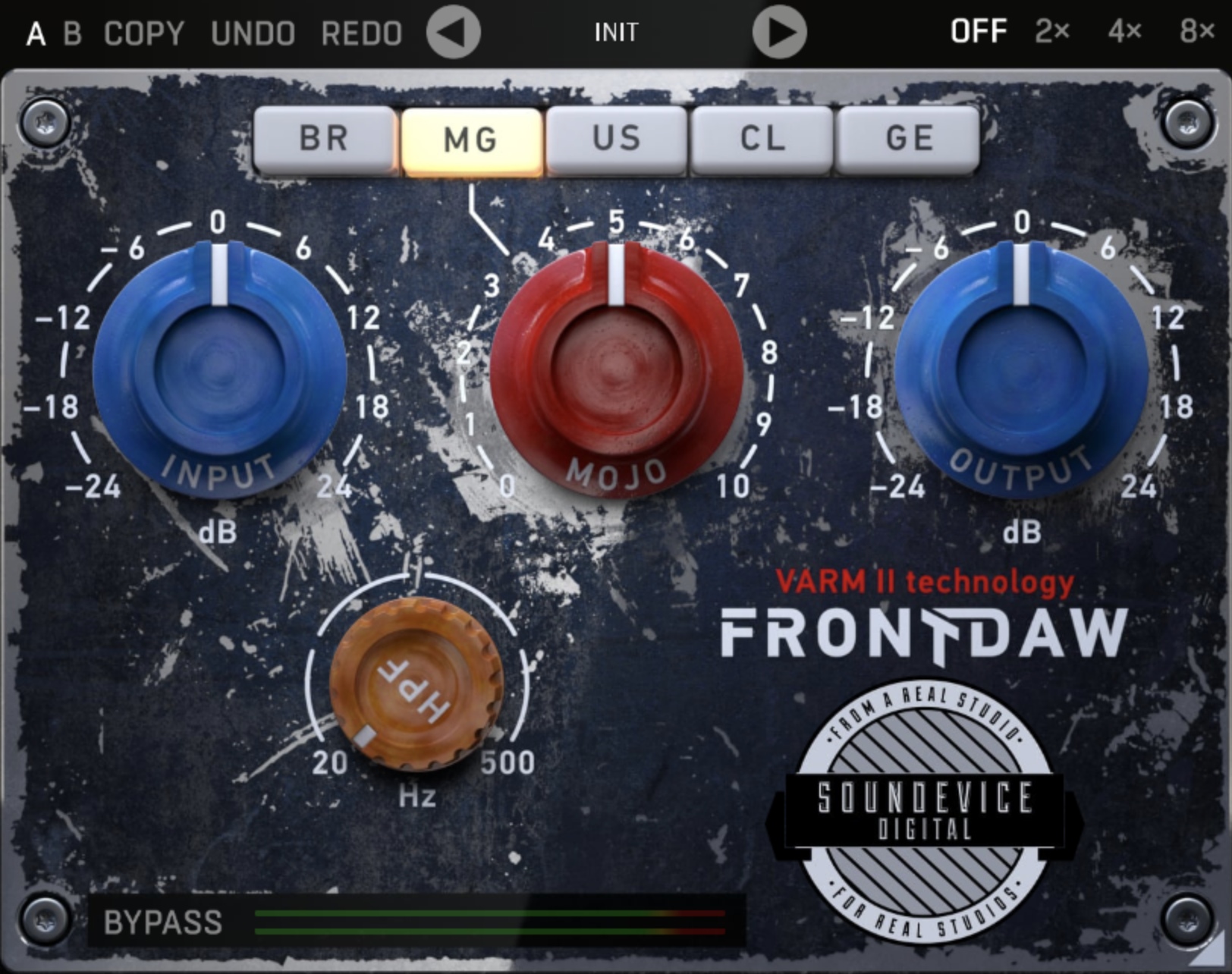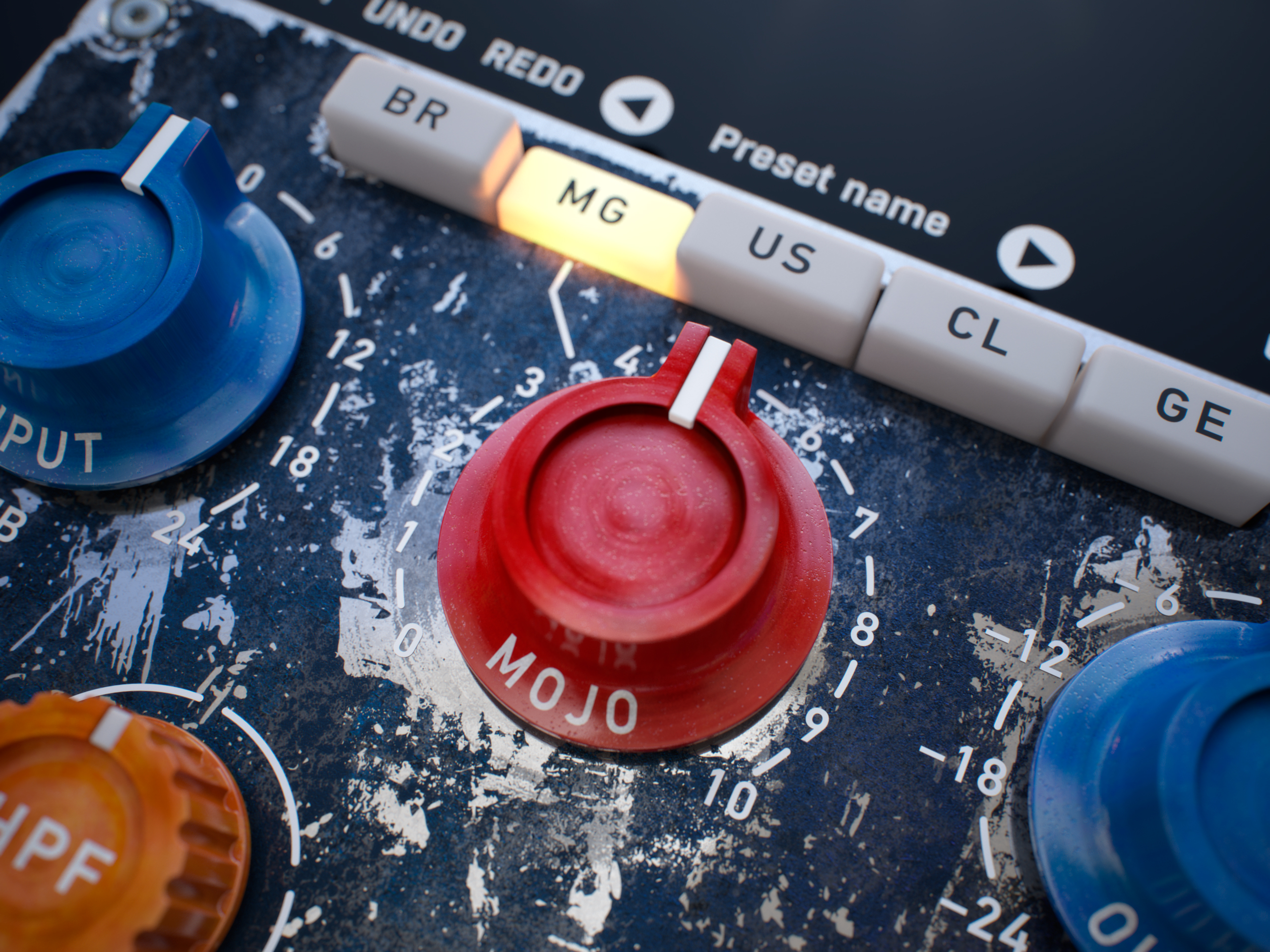Front DAW User Manual
Front DAW Controls
Front DAW‘s simple user interface easily adapts to your screen – it will be the same size on any screen, whether it is low-DPI or modern high-DPI/retina. Drag the bottom right corner to change the GUI size. Make it smaller to save valuable screen space, or enlarge it to make it easier to use.

Input Control: Input control is basically Gain in. Controls how much signal is going in the Front DAW plugin. The range is from -24 to +24dB
Output Control: Determines the master output volume. The range is from -24 to +24dB
Logo: The Logo Colour changes indicate the level of incoming signal.
BR/MG/US/CL/GE Buttons: Change the behaviour of the analogue circuit and change colour (British, Magnetic (tape), American, Clipper and German style preamp).
HP Filter: Hipass filter can be set from 0 to 500 Hz
Mojo: Controls how much colour is in the signal.
Meters: Represent input and output volumes. The input meter is placed after the input gain.
Oversampling OFF/2x/4x/8x: Front DAW performs solid nonlinear processing, so it can produce aliasing when pushed too hard. In these cases, oversampling would help by processing at higher sampling rates. The cost is much higher CPU usage and latency (therefore it cannot be used in live scenarios). Always check closely to see if it actually improves the sound quality, and if not, do not use it. Do not use oversampling "just in case"; use it only when there's a benefit.
Right-click
Right-click anywhere in the plugin background with the right mouse button, and you will get access to the following features.
Change oversampling settings (Plugins that support oversampling only)
Scale GUI precisely by percentage.
Get the version info.
Access product web page, reach support and access online documentation.
Contact support
Open the presets folder (to add, arrange or delete presets manually)
Activate/Deactivate the plugin
Access Licence Manager (to activate or deactivate the plugin or several plugins at the same time)
Disable/Enable GPU Acceleration.
Disable/Enable the Intelligent sleep on silence function that disables the plugin when no sound is on input or output to save the CPU power.
Right-click any control (knob, button) to access help for the particular parameter.
Double-click Menu
Some parameters let you access more accurate numeric settings by double-clicking the knobs.
Top bar
A, B and Copy buttons - The plugin remembers two sets of settings, A and B. Clicking any of these two buttons switches between these two settings. The selected one is highlighted in red. This is a great way to check A/B and select the best settings. The "Copy" button copies the current settings to the other slot (if A is currently selected, the button will copy the current settings to slot B).
LINK - The Link button connects the input and the output volume controls to maintain the same overall volume. Turning up input gain lowers the output volume and vice versa.
Presets - The plugin comes with a set of presets, which should do the trick for most cases or give you a good starting point when tweaking your sound. Access them using the right and left arrows or by clicking the preset field directly. You can save and manage your own presets there as well. In your computer, presets are stored in the following paths:
Windows:
C:\Users\username\Documents\SoundeviceDigital\FrontDAW
Mac OS X:
HOME/Documents/SoundeviceDigital/FrontDAW
Installation and maintenance
Installation is a quick and simple process involving downloading and using a standard installer on both platforms, Windows and Mac OS X. The installer places the plugins and presets into proper locations so that your DAW can easily find them. The plugin is available for all relevant interfaces: VST, VST3, AAX and AU. Note that on OS X, since High Sierra, you may need to restart your computer to make your DAW find new plugins.
If you are having trouble, please contact us at support@unitedplugins.com.
Updating
Updating the plugin to the newest version is as simple as using the newest installer.
Uninstallation
Windows:
You can either use the link to the uninstaller in the start menu by typing Front DAW, for example, or it can be accessed via Control panels / Applications /
MacOS X:
First, delete the plugin files manually from the:
AU: /Library/Audio/Plug-Ins/Components
VST: /Library/Audio/Plug-Ins/VST
VST: /Library/Audio/Plug-Ins/VST3
AAX: /Library/Application Support/Avid/Audio/Plug-Ins
Then, if you really want to get rid of all data created by the plugin, remove the following folders as well:
HOME/Documents/SoundeviceDigital/FrontDAW
HOME/Library/Application support/SoundeviceDigital/FrontDAW
Note: Since OS X 10.7 (Lion), many folders are marked as hidden by default. To make them visible again in Finder, please follow this tutorial:
https://ianlunn.co.uk/articles/quickly-showhide-hidden-files-mac-os-x-mavericks/
Trial and activation
FrontDAW is initially in demo mode, which lets you evaluate the plugin. Try it in your mixing/mastering sessions, and make sure it really does the trick. When ready, purchase a licence from our shop or any of our resellers. You will receive a so-called licence file, which you download to your computer. The plugin displays an ACTIVATE button when in trial mode. Click it and select the licence file. The plugin will check the licence and activate it on your computer. After you restart your DAW, the plugin will be activated and will work indefinitely without restrictions. You can use the plugin on all your computers.
Support
Now that you’ve taken the time to learn all about Front DAW, enjoy and make your sound awesome! If our plug-ins helped you take your production to the next level, let us know. We’d love to hear from you about what you were able to create with our software.
If you encounter any problems, we offer free technical support for all registered users. Start with the frequently asked questions here:
http://www.unitedplugins.com/faq
If you need further assistance, you can find our Customer Support contact form at:
http://www.unitedplugins.com/contact
You can also reach our support staff by e-mail at:
support@unitedplugins.com


